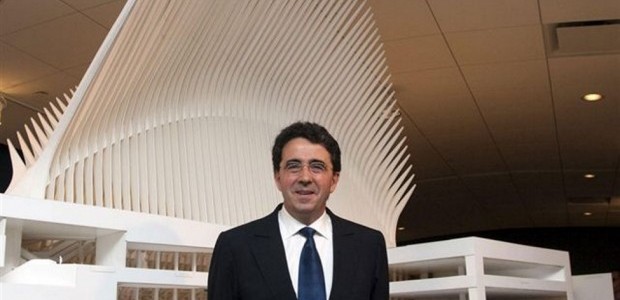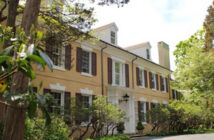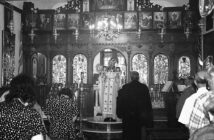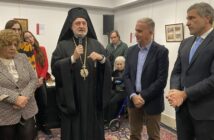Source: The National Herald
By Theodore Kalmoukos
NEW YORK – Santiago Catralava, the prominent architect selected to design the New St. Nicholas Greek Orthodox Church at Ground Zero, has a record replete with problematic projects and designs and legal problems, TNH has learned.
De Zeen Magazine’s January 2 article, “Newer Story Older Story, Valencia to sue Calatrava over Falling Masonry at City of Arts and Sciences,” stated among other things that “Calatrava is facing legal action from his home city of Valencia [Spain] because parts of the opera house roof at his City of Arts and Sciences complex are falling off just eight years after completion.
“Sections of the mosaic roof of the Palau de les Arts Reina Sofia opera house at the Ciudad de las Artes y las Ciencias de Valencia came away in high winds, forcing authorities to cancel performances and close the building to the public.
“Regional government spokesman Maximo Buch announced that Valencia would sue Calatrava and his architectural firm for the cost of repairs, and said that the building will remain closed until it can be made safe again.”
The article also stated that “the opera house is one of seven buildings that comprise the City of Arts and Sciences complex, opened in October 2005 and constructed on reclaimed land in the city’s former port. The white concrete opera house features a feather-like roof sailing over two outer shells that curl round the sides. These are clad in a layer of ceramic mosaic tiles or ‘trencadis,’ which first showed signs of ageing a year ago when wrinkles appeared in the smooth white surface and is now coming away in chunks.
“Calatrava has been heavily criticized for the cost of the City of Arts and Sciences complex and was accused of ‘bleeding Valencia dry’ over alleged fees of €100 million for the showpiece cultural centre, despite it coming in four times over budget at over €1 billion.
“The starchitect is no stranger to legal disputes over his buildings and had to pay €3.3 million to settle a dispute last June after a conference centre he designed in the northern Spanish city of Oviedo suffered structural collapse.
“Another problem that Calatrava had was in Spain as well. The owners of the Ysios winery in Spain have launched legal action demanding he pays €2 million so they can appoint a new team of architects and engineers to fix the building’s leaky roof, following repeatedly failed attempts by Calatrava’s builders to solve the problem.
“Also the bridge in Billbao proved to be problematic as well. This footbridge to the Guggenheim museum in Bilbao has caused controversy, with the city having to pay compensation to dozens of pedestrians who slipped on the glass surface in wet weather, while Calatrava is also being taken to court due to his footbridge over the Grand Canal in Venice coming in three times over budget and requiring what the city sees as excessive repairs.”
The Architectural Record in a December 11, 2007 article titled “Judge Rules Against Calatrava in Bilbao Suit” wrote that “a civil judge in Bilbao, Spain, has ruled against Santiago Calatrava in his suit challenging Arata Isozaki’s addition to his 1997 footbridge over the Nervión River. The addition was built without Calatrava’s knowledge and opened last February. In the first test of Spain’s Law of Intellectual Property applying it to a work of engineering, Calatrava sued the City of Bilbao, which owns the bridge, and the two local contractors that built the addition, demanding that the extension be demolished and that he be awarded $365,000 in damages—or $4.3 million if it was not removed.”
The New York Times in the September 24 article “A Star Architect Leaves Some Clients Fuming, Santiago Calatrava Collects Critics as Well as Fans” wrote that “in Bilbao, Spain, a Calatrava footbridge paved with glass tiles now has a dark carpet because so many pedestrians slipped and fell.
“The station [has been]under construction this summer. It is opening far behind schedule at double the original cost. But these days, even as Mr. Calatrava’s eye-catching PATH station creeps toward completion in Lower Manhattan, he is often cast as a villain here in Valencia. One local politician runs a website called Calatravatelaclava, which loosely translates as, ‘Calatrava bleeds you dry.’
“Originally budgeted at 300 million euros (about $405 million), the riverbed complex, called the City of Arts and Sciences — the world’s largest collection of Mr. Calatrava’s work, which includes a performance hall, a bridge, a planetarium, an opera house, a science museum, a covered walkway and acres of reflecting pools — has cost nearly three times that much, money the region never had.
“Ignacio Blanco, the member of the provincial Parliament who started the website, has unleashed a flood of information about the complex during the past year, concluding that Valencia still owes 700 million euros (about $944 million) on it.
“Mr. Calatrava was paid approximately 94 million euros (about $127 million) for his work. How could that be, Mr. Blanco asks, when the opera house included 150 seats with obstructed views? Or when the science museum was initially built without fire escapes or elevators for the disabled?”
Recently, some essential questions have arisen in the Church and the Greek-American community circles regarding the assignment of the designs of the new St. Nicholas Church to Calatrava. Who from the Greek-Orthodox Archdiocese and with what criteria selected Calatrava to design the St. Nicholas Church, and why wasn’t a Greek-Orthodox architect chosen instead? Does the Archdiocese know about the problems that Calatrava has had? Has Calatrava designed any other Greek-Orthodox church?
The new St. Nicholas Church is expected to open its doors in early 2016.
[subscribe2]



